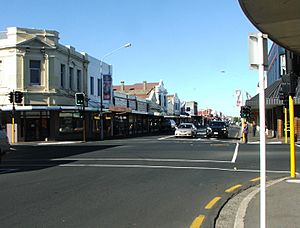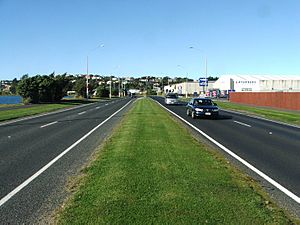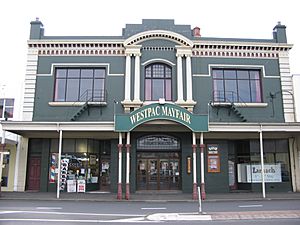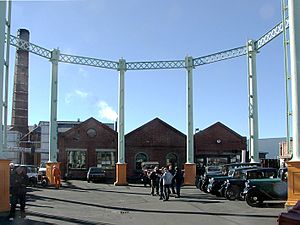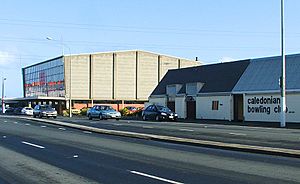South Dunedin facts for kids
|
|
||
South Dunedin is a busy part of the city of Dunedin in New Zealand. It's about 2.5 kilometers (1.5 miles) south of the city center. This area is on a big flat piece of land, which locals simply call "The Flat."
South Dunedin has a mix of different things. You'll find factories, shops, and many homes here. Sometimes, when people say "South Dunedin," they mean all the nearby areas on "The Flat." This includes places like St Kilda, Forbury, Kensington, Musselburgh, and Tahuna.
Contents
Exploring South Dunedin's Geography
The flat land that makes up much of Dunedin's center is surrounded. To the south and east, you'll find Otago Harbour. To the north and west, there's a ridge of hills.
In the past, this flat area was quite swampy. But now, it has been drained and expanded. This is where South Dunedin is located today.
The exact borders of South Dunedin can be a bit unclear. It used to be a separate town a long time ago. However, those old borders are not often used anymore.
One clear border is with St Kilda. Bay View Road is still seen as the line between these two areas. A main road, King Edward Street, even changes its name to Prince Albert Road when it crosses into St Kilda.
To the east, Otago Harbour is a natural boundary for South Dunedin. To the north, the hills also form a natural edge. At the bottom of these hills are the suburbs of Kensington and Caversham. Caversham also marks the western edge of South Dunedin.
The Southern Endowment: Land from the Harbour
A large part of eastern South Dunedin is land that was created from Otago Harbour. This area is called the Southern Endowment. It covers about 100 hectares (250 acres).
Work on the Southern Endowment began in the 1800s. Rocks from cutting down Bell Hill in the city center were used. This helped expand the area around the wharves.
Later, in 1912, a causeway was built along the harbor's edge. From the 1940s, dredges pumped sand and dirt behind this causeway. This process of creating new land continued for many years.
The Southern Endowment was officially finished in 1978. That's when Portsmouth Drive opened. This road runs along where the 1912 causeway was built.
Most of the Southern Endowment is used for factories and storage. However, it also has a small park near the wharf. The large sports complex, The Edgar Centre, is also located here.
Cargill's Corner: A Shopping Hub
South Dunedin has the city's second most important shopping area. It's centered around a place called Cargill's Corner. This corner is named after Captain William Cargill. He was a founder of the Otago region.
At Cargill's Corner, two main roads meet: King Edward Street and Hillside Road. There's also a small shopping mall here called South City.
For many years, Cargill's Corner had a special pedestrian crossing. It was called a "Barnes Dance" crossing. This means all traffic stops, and people can cross in any direction, even diagonally. Its use stopped in the 1980s. In 2011, the city thought about bringing it back, but they didn't.
King Edward Street runs north-south. It connects to Princes Street and the city center in the north. To the south, it leads to the busy coastal area of St Kilda.
Hillside Road connects Andersons Bay Road in the east. Andersons Bay Road is another important road. To the west, Hillside Road links to Caversham, Corstorphine, and Saint Clair.
Major Roads in South Dunedin
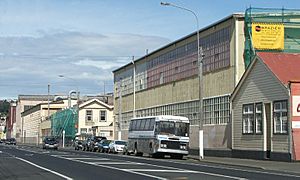
Smaller, older shops spread out from Cargill's Corner. You'll find them along King Edward Street to the south and Hillside Road to the west.
To the east, along Hillside Road and Andersons Bay Road, are bigger stores. These include large supermarkets like Pak'n Save and Countdown. You'll also find stores like The Warehouse and Mitre 10 Mega.
Further along Andersons Bay Road, and to the west on Hillside Road, are many car dealerships. There are also light industrial businesses. These areas extend into Caversham in the west. They also go across the reclaimed land between Andersons Bay Road and Portsmouth Drive.
Andersons Bay Road runs roughly parallel to King Edward Street. It's about 0.5 kilometers (0.3 miles) to the east. This road connects to State Highway 1 in the north. It also leads to the suburb of Musselburgh in the south. This road is also a main route from the city center to Otago Peninsula.
Portsmouth Drive is another important road. It's about 0.6 kilometers (0.4 miles) further east. This road runs along the edge of Otago Harbour. It's on the edge of the reclaimed Southern Endowment land. Portsmouth Drive connects the city center to Portobello Road. Portobello Road is a long, winding road that goes along the harbor side of Otago Peninsula. Portsmouth Drive is named after Dunedin's sister city in the United States, Portsmouth, Virginia.
Other important roads in South Dunedin include Timaru Street. This street is on the Southern Endowment. Several other streets cross King Edward Street. They link it with Andersons Bay Road to the east. Or they connect to the suburbs of Saint Clair and Forbury in the west. These include Macandrew Road, Melbourne Street, McBride Street, and Bay View Road. Bay View Road forms the border between South Dunedin and St Kilda.
South Dunedin's Past
Before European settlers arrived, much of "The Flat" was wet and swampy. Early settlements were built along the hills. These were in places like Caversham and St. Clair.
In 1849, William Henry Valpy arrived in St Clair. He was said to be the richest man in New Zealand. He had a road built from Dunedin's main settlement to his farm in St. Clair. This road ran along the edge of what is now South Dunedin.
In the 1860s, the city grew very fast because of the Otago Gold Rush. More people settled, especially around what is now Hillside Road.
Chinese settlers were among the first people to live in the St Clair area. They worked hard to drain the swampy land near the beach. They turned it into market gardens. Many of the city's vegetables came from these Chinese gardens. They were located near Macandrew Road, Forbury. There were also gardens in Andersons Bay and Tainui. A quarry opened in the Forbury area. It provided building materials for the growing city. This also helped the southern part of the city develop.
South Dunedin became its own town, called a borough, in 1876. By the early 1900s, it was a busy town with factories and homes. A book from 1905, Cyclopedia of New Zealand, described it:
"The Forbury public school, St. Patrick Catholic school, and a convent and orphanage are situated in the borough, which contains, also, the Dunedin City Corporation gasworks, a rope and twine factory, a fruit preserving factory, a box factory, and furniture workshops. There are Presbyterian, Wesleyan, Baptist, and Roman Catholic churches, and Salvation Army barracks; and members of the Church of Christ hold services in the Town Hall. The Borough Council has an endowment of 155 acres on the harbour front, which is leased, in small sections, to ratepayers who desire to build in that quarter. The Town Hall was built in 1902, at a cost of £2,118, and contains a spacious council-room, offices, and strong room. The hall is much used for lectures, dances, and other forms of entertainment, and is centrally situated on the Hillside road, the main business thoroughfare of the borough. There are four licensed hotels in the district, also a volunteer Fire Brigade and station, maintained at a cost of about £60 a year. The streets are well formed, and lighted with twenty-five gas lamps, and the footpaths are asphalted and kept in good order."
In 1905, South Dunedin joined with Dunedin City. Its neighbor, Caversham, had joined a year before.
South Dunedin has faced challenges from nature. In 1923, a big storm brought heavy rain. This caused a lot of flooding in South Dunedin, Caversham, and St Kilda.
In June 2015, South Dunedin had more serious flooding. A low-pressure weather system brought heavy rain. The high water level underground made the flooding worse. Also, a pumping station broke down. About 1,200 homes and businesses were damaged. The total cost of the flood damage was about $138,000,000.
Mayors of South Dunedin Borough
South Dunedin had its own mayors when it was a separate borough. Here is a list of the people who served as mayor from 1876 until it joined Dunedin City in 1905:
| Name | Term | |
|---|---|---|
| 1 | Nicholas Moloney | 1876–1877 |
| 2 | Gabriel Hodges | 1877–1879 |
| (1) | Nicholas Maloney | 1879–1880 |
| 3 | George McBride | 1880–1882 |
| 4 | Joseph Osmond | 1882–1883 |
| 5 | William Wardrop | 1883–1887 |
| 6 | Michael Sullivan | 1887–1890 |
| (5) | William Wardrop | 1890–1892 |
| 7 | Henry Henderson | 1892–1893 |
| 8 | Ephraim Osborne | 1893–1894 |
| (5) | William Wardrop | 1894–1895 |
| 9 | Charlie Fisher | 1895–1898 |
| 10 | Thomas Fiddis | 1898–1901 |
| 11 | Andrew Todd | 1901–1902 |
| 12 | John Chetwin | 1902–1904 |
| 13 | John Shacklock | 1904–1905 |
People and Population
South Dunedin is divided into two main areas for counting people. These are Hillside-Portsmouth Drive and Bathgate Park. Hillside-Portsmouth Drive mainly has factories and warehouses. Bathgate Park has homes and shops.
Hillside-Portsmouth Drive Population
This area is about 1.36 square kilometers (0.53 square miles). In 2018, it had 99 people living there. This was an increase from 75 people in 2013. Most people were European, but there were also Māori, Pasifika, and Asian people. Many people here had no religious beliefs.
Bathgate Park Population
This area is about 0.53 square kilometers (0.20 square miles). In 2018, it had 2,439 people living there. This was an increase from 2,310 people in 2013. The median age was 49 years old. Most people were European. There were also Māori, Pasifika, and Asian people. Many people here had no religious beliefs, while others were Christian.
Cool Places to See in South Dunedin
A big industrial area in South Dunedin is the Hillside Railway Workshops. These workshops are just west of Cargill's Corner. They cover about 8 hectares (20 acres) and extend into the nearby suburb of Caversham.
Other important buildings include the Mayfair Theatre. It's near Cargill's Corner. The Edgar Sports Centre is at the southeastern edge of the suburb on Portsmouth Drive. The Mayfair Theatre is a historic building. It has a Category II classification from the New Zealand Historic Places Trust (NZHPT).
The city's old main sports complex, Carisbrook, is close to South Dunedin. It's in Caversham. Another old stadium, the Caledonian Ground, used to be where The Warehouse store is now. It was moved in 2000 to Logan Park in Dunedin North. The corner of Andersons Bay Road and Hillside Road is still sometimes called "Caledonian Corner."
This corner is also where the country's longest-running gasworks used to be. It operated from 1863 to 1987. A small museum, the Dunedin Gasworks Museum, is on the southern part of its site. It's on Braemar Street. The museum opened in 2001. It's one of only three preserved gasworks museums in the world! It has five old steam pumping engines. These were used in the gasworks. There's also an even older engine from Scotland, brought over in 1868. Three buildings at the Gasworks are historic. They have NZHPT Category I classifications. These include the frame of the 1879 gasometer, the exhauster and boiler house, and the fitting shop.
South Dunedin has several interesting churches. Two of them are also historic. St. Michael's Antiochian Orthodox Church is on Fingall Street. It's the city's only Eastern Orthodox church. St. Patrick's Roman Catholic Basilica is on Macandrew Road. It was designed by Francis Petre. Both have NZHPT Category II classifications.
Past Landmarks of South Dunedin
South Dunedin has many connections to Dunedin's industrial past. One important factory was G. Methven. This company made bathroom fittings. It was on Andersons Bay Road for many years. Now, a Mitre 10 megastore is on that site.
Across the road from this was Moreau College. This was a secondary school for girls. In 1989, it joined with St. Paul's High School for boys. They became Kavanagh College. The Moreau site was closed. The new school continued at the St Paul's site.
Another past landmark was the former Caledonian sports ground. It was opposite the gasworks. This site is now the car park for The Warehouse. All that's left of the original sports complex is a lawn bowls club and a gymnasium. The gymnasium is also South Dunedin's main war memorial.
The Caledonian was famous for a special event. On January 21, 1889, Thomas Scott Baldwin made the first human flight in a hot-air balloon in New Zealand here. He also made the first parachute descent!


